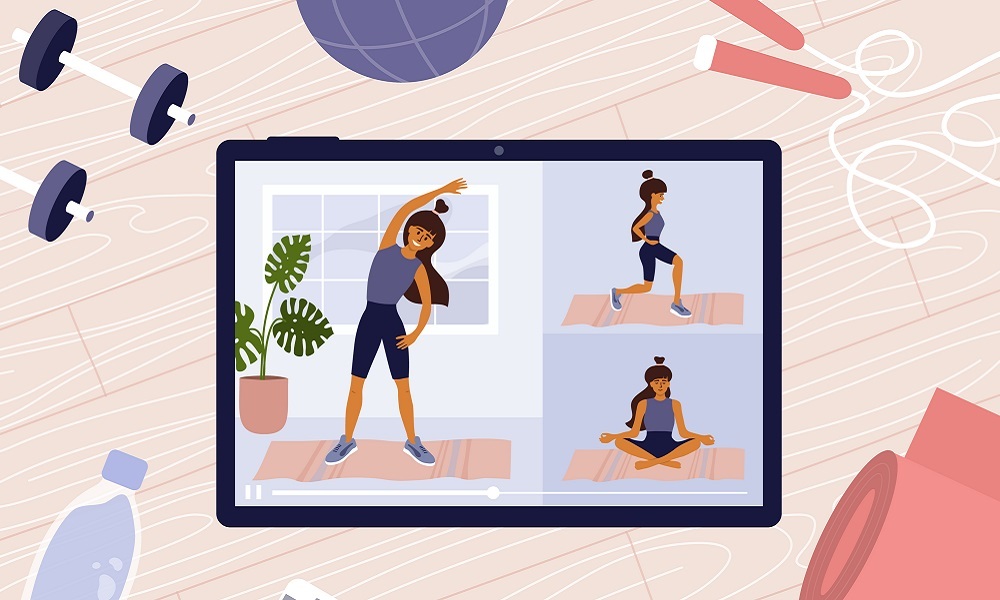With gyms and swimming pools closed, group fitness classes cancelled and community sports on hold, how are people managing to keep fit throughout the COVID-19 pandemic?
Research from Deakin University has found that people are turning to digital platforms like YouTube, Facebook, Zoom and fitness apps as an effective way to stay fit when access to other forms of organised exercise is restricted.
Dr Kate Parker is a Lecturer and Postdoctoral Research Fellow at Deakin University's Institute for Physical Activity and Nutrition (IPAN). Along with her colleague Dr Lauren Arundell, Parker has been leading the Our Life @ Home study – a national longitudinal study that aims to examine changes in activity-related behaviours, health and wellbeing, and identify the factors that may influence these at the beginning, during and after the COVID-19 pandemic.
Recent data collected for the study show that throughout extended lockdowns and stay-at-home orders, people who used digital platforms to access facilitated classes or online and app-based fitness programs were more likely to meet physical activity guidelines than those who didn't.
‘For adults, those who were using these platforms to be active at home during lockdowns were two times more likely to meet the moderate to vigorous intensity, aerobic physical activity guidelines,’ Parker tells Wellbeing by Teacher.
‘They were over three times more likely to meet the muscle strengthening guidelines of two or more sessions per week, and also just under three times more likely to meet the combined guidelines of both the aerobic and strengthening guidelines, compared to those who weren’t using them. So obviously for adults, you can see these online offerings have been really, really helpful.’
In this study, purpose-designed online surveys were distributed to adults (aged 18-75 years) and also to adolescents (aged 13-17 years) in Australia.
How many people are using the digital platforms?
Prior to the COVID-19 pandemic, Parker says data show that around a quarter of people used healthy lifestyle apps and platforms. During the initial lockdowns in April/May 2020, Parker says they saw almost 40 per cent of adults in her sample were using them.
When participants were followed up with in August/September (while Victoria was in lockdown but the other states and territories weren’t), Parker says they found that the usage in Victoria had increased almost two-fold.
‘Under extended lockdowns, they became more and more popular but we saw that the adults in the other states of Australia, their usage actually decreased again once they were no longer under those stay-at-home orders,’ Parker shares.
‘We did then collect some more data about two months ago, we’re yet to delve into it but it will be really interesting to see what’s happened to the usage over a year down the track, across the country and under different circumstances.’
The popular platforms that people use
The researchers also looked at the types of digital platforms people were using during the lockdowns, and whether the use of those platforms was associated with physical activity levels.
‘What we actually found was that the most popular platforms were ones that could be freely accessed and available at all hours of the day. So social media – YouTube, those sorts of things, were really popular and the people who were using those were actually two to four times more likely to meet those physical activity guidelines that we know are important for maintenance of good health and wellbeing,’ Parker says.
Earlier this year, Parker also conducted a separate study with teenage girls aged 15-17 to find out which platforms they were using to keep active. Unsurprisingly, social media apps like Instagram, YouTube and TikTok proved the most popular.
‘It’s funny because you think that people use apps a whole heap but the data we’ve collected from both the Our Life @ Home study and then this teenage girl study was that apps weren’t as popular – those purpose built apps, compared to the social media ones,’ Parker shares.
‘I guess because the social media apps, you get something new every day, it’s always fresh content and there’s something at all hours. There’s such a broad range of opportunities available on there – you’ve got Pilates, yoga, body weight, strength exercises, HIIT style aerobic exercises, you’ve got dance classes … anything.’
Facebook has proved popular for establishing community groups where people have a safe space to connect with like-minded people and talk about health and wellness issues. And of course, during the most severe lockdowns, platforms like Zoom and Microsoft Teams were widely used to facilitate live fitness classes.
Exercises most adaptable to the online environment
Parker says that some exercises are more adaptable to the online environment than others, particularly those that don’t require a lot of equipment, can be done using body weight, and are easily done in a small, confined space.
‘That’s the reason why we found that people who were using the platforms were more likely to meet those muscle strengthening guidelines because things like squats and pushups and burpees and body weight activities are really easily adaptable to the online setting,’ Parker explains.
‘I think it might be why we see a greater proportion of females using the platforms compared to males, because we know that typically males are more heavily involved in sport and strengthening exercises that require equipment and weights, versus females who are more into Pilates and yoga and aerobic exercises,’ she adds.
Digital platform use in the future
Parker says that while they haven’t published any new data on this yet, it will be interesting to see whether people continue to use digital platforms for fitness once they’re no longer under stay-at-home restrictions.
‘I think the uncertainty of it all might stop people from returning to gyms as much,’ she says. ‘Having the apps, YouTube and different social media platforms and the things that you know are always going to be there, they’re always going to be accessible, even in times of lockdown; it might mean that over this continued COVID era, we might see that usage continues to stay high, even when things open back up again.’
Further reading
Parker, K., Uddin, R., Ridgers, N. D., Brown, H., Veitch, J., Salmon, J., Arundell, L. (2021). The Use of Digital Platforms for Adults’ and Adolescents’ Physical Activity During the COVID-19 Pandemic (Our Life at Home): Survey Study. Journal of Medical Internet Research, 23(2), e23389.
Are you an educator working in a school setting? If so, are you interested in submitting an article for publication on Wellbeing by Teacher? We’d love to hear about how you care for your own wellbeing. Reach out to the team by emailing teacherwellbeing@acer.org with your story idea. We’ve also put together a handy guide to help you get started.


